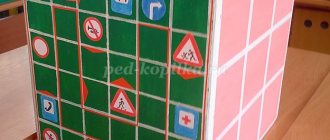Answers to problems on ecology Olympiad 5, 6 grade 2016-2017
1st ALL-RUSSIAN OLYMPIAD FOR SCHOOLCHILDREN IN ECOLOGY. 2016–2017 academic year SCHOOL STAGE. GRADES 5–6 Assignments, answers and assessment criteria All points for six assignments are summed up in the final grade. The maximum number of points is 40. 1. Forest is a natural community. (6 points) Arrange forest organisms in the order of changing tiers from bottom to top: shrubs mosses and lichens shrubs and grasses trees Name the types of organisms that belong to each of the proposed tiers. The correct sequence is: mosses and lichens - shrubs and grasses - shrubs - trees. Scoring: 0.5 points for each correct position. Examples of types of organisms: mosses and lichens - cuckoo flax, moss (reindeer moss), sphagnum; shrubs and herbs - blueberries, lingonberries, sedges, strawberries, lilies of the valley, etc.; shrubs – willow, viburnum, euonymus, hawthorn; trees - pine, spruce, birch, aspen. Scoring: 1 point for each correct position (one example is enough). Total – 6 points. 2. Food connections in ecosystems. (5 points) Fill in the blanks in the proposed food chains: a) flower nectar → butterfly → tit → ? b) wood → ? → woodpecker c) leaves → ? → cuckoo d) aquatic insects → ? → heron e) grass → grasshopper → ? > butterflies (leaf beetles, silkworms, leaf rollers) → cuckoo d) aquatic insects → frog (roach, newt, tadpoles) → heron d) grass → grasshopper → mouse (vole, shrew, lizard) → All-Russian Olympiad for schoolchildren in ecology 2016– 2017 academic year d. School stage. Grades 5–6 2 Assessment: 1 point for each correct answer. Total – 5 points. 3. The influence of external factors on organisms. (10 points) All living organisms are influenced by various factors or environmental conditions. From the following, select which of them are factors of inanimate nature, which are the result of the action of other living organisms, and which are the result of human activity: a) weather conditions b) the influence of predators c) lack of suitable trees for nesting d) infestation by parasites e) deforestation f) climate change g) overgrowing of fields h) spring flood i) shading of herbaceous plants by trees j) burning of grass Correct answers: factors of inanimate nature - a, f, h; factors of living nature – b, c, d, g, i; factors associated with human influence – d, j. Scoring: 1 point for each correct answer. Total – 10 points. 4. Adaptations of organisms. (12 points) What are the main structural and vital features that help the following organisms exist in nature? Explain how. a) blue whale b) English oak c) mallard duck Correct answers should contain the following explanations: a) Blue whale - it is necessary to describe the structural features of the whale that allow it to move in water (streamlined body shape, tail transformed into a caudal fin, forelimbs transformed in fins – indicate at least 2 of the 3 listed); feeding on numerous small (planktonic) organisms and the presence of a filtration apparatus - whalebone; diving and surfacing to breathe atmospheric air; a developed brain that enables complex behavior. All-Russian Olympiad for schoolchildren in ecology 2016–2017 academic year. d. School stage. 5–6 grades 3 b) English oak - this tree has large leaves (increasing the surface area for photosynthesis (i.e. for nutrition), a powerful and durable trunk that resists winds and bad weather, a thick bark that protects from damage and freezing , powerful and deeply growing roots for obtaining water and minerals. c) Mallard - first of all, it is necessary to indicate the adaptations to the aquatic lifestyle: webbed feet for swimming, a long flat beak with plates for filtering aquatic organisms during feeding, a long neck for immersing the head in water for nutrition, dense plumage, covered with a special secretion (coccygeal gland) to protect it from getting wet. Scoring: 1 point for each correct item (highlighted by a line) in the answer. Total – 12 points. 5. Adaptations of organisms. (3 points) What do zebras and ostriches have in common in terms of adapting to living conditions in open spaces? Correct answers should include the following explanations: Both the ostrich and the zebra lead a group lifestyle, which increases the chance of early detection of an approaching predator. Both species have long limbs with a reduced number of fingers, allowing them to escape from predators, and a head raised above the body, which allows them to observe a larger territory. Scoring: 1 point for each correct item (highlighted by a line) in the answer. Total – 3 points. 6. Interaction of organisms with each other and with their environment. (4 points) What could be the reasons limiting the number of pairs of great tits (nesting in hollows) in the old city park and in the young forest? Correct answers should contain the following explanations: In an old city park, the number of tits limits the territorial behavior of males, and in a young forest - the number of available hollows. Scoring: 2 points for each correct item (highlighted by a line) in the answer. Total – 4 points.
Olympiad tasks in ecology, grade 6
Olympiad in ecology 6th grade.
I. Tasks with one correct answer.
Task 1. Of the named plants, the following can be considered algae:
A) duckweed B) elodea C) seaweed D) water lily
Task 2. Chloroplasts are found in cells:
A) oak root B) amoeba C) fruiting body of tinder fungus D) garden strawberry leaf
Task 3. Antibiotics are prepared from:
A) mucor B) yeast C) penicillium D) ergot 4. Seasonal changes in plant life are studied by:
A) botany B) biology C) geography D) phenology
Task 5. Which of the named mushrooms belongs to the lamellar
A) boletus B) oiler C) camelina D) boletus
Task 6. Gymnosperms include:
A) cedar, thuja, sequoia B) pine, spruce, banana C) yew, coconut, cypress D) juniper, larch, date palm
Task 7. In woody plants, the cambium is laid
A) the same number of cells towards the wood and towards the bark B) there are more cells towards the wood than towards the bark C) there are more cells towards the bark than towards the wood D) cells are deposited only towards the wood
Task 8. What contributed to the spread of flowering plants on our planet:
A) reproduction without water B) the presence of plastids in cells C) diversity of life forms D) diversity of root systems
Task 9. Which of the following plants are classified as monocots:
A) sunflower B) rowan C) feather grass D) clover
Task 10. Cruciferous plants include:
A) sweet clover B) field grass C) field pea D) lily of the valley
Task 11. Bacteria exist on Earth along with more highly organized creatures, since they:
A) consist of one cell B) have microscopic dimensions C) use various organic substances for nutrition D) multiply quickly and form spores in unfavorable conditions
Task 12. What plant and animal cells have in common is
A) the presence of chloroplasts B) the presence of a nucleus C) the method of nutrition D) the structure of the cell wall
Task 13. Capable of photosynthesis
A) green euglena B) common amoeba C) ciliates - slipper D) Giardia intestinalis
Task 14. Protozoan cell
A) performs a specific function B) is an independent organism C) is an integral part of tissues D) has a dense shell
Task 15. The causative agent of malaria is:
A) malarial mosquito B) malarial plasmodium C) dysenteric amoeba D) ciliate - slipper
Task 16. The supporting function in the plant body is performed by tissue:
A) epithelial; B) mechanical; B) connecting; D) conductive.
Task 17. The ozone layer protects:
A) the planet from the fall of meteorites; B) living organisms from harmful radiation; C) the planet from heat loss; D) from space cold.
Task 18. The cellular structure is:
A) plant; B) mushrooms; B) animals; D) all living organisms.
Task 19. Nutrition is:
A) supply of oxygen to the body; B) release of unnecessary substances; C) obtaining necessary substances from the environment; D) digestion of food.
Task 20. Nucleic acids perform:
A) the function of storing and transmitting hereditary characteristics; B) energy function; B) support function; D) reproduction function
II. Tasks with multiple correct answers.
Task 1. Plants that flower and bear fruit once in a lifetime, after which they die completely, belong to the group of monocarpics. Which of the following plants should be included in this group?
I. Agave. II. Sedge. III. Bamboo. IV. Sugar cane. V. Date palm.
a) I, II, V; b) I. III; c) I, V; d) I, III, IV.
Task 2. Representatives of the type of mollusks live
a) in volcanic lava b) in the seas c) in fresh water bodies d) on land
Task 3. Scorpios are representatives
a) multicellular b) crustaceans c) arachnids d) arthropods
Task 4. What systematic categories are used to classify plants
a) type b) squad c) class d) department e) order f) subtype
Task 5. Potatoes serve as raw materials for manufacturing
a) paper b) artificial rubber c) nylon d) alcohol e) starch
III. Choose the correct judgments.
1) Mosses belong to higher spore plants 2) Spores in cuckoo flax develop in capsules 3) Reproduction in mosses is not associated with water 4) Mosses have developed stems and leaves 5) Rhizoids are not developed in cuckoo flax 6) All life forms are found among mosses 7) Lichens reproduce by seeds Polypores are in symbiosis with trees 9) The taste organs of flies are on the paws 10) Migratory birds build nests in the south.
Polypores are in symbiosis with trees 9) The taste organs of flies are on the paws 10) Migratory birds build nests in the south.







